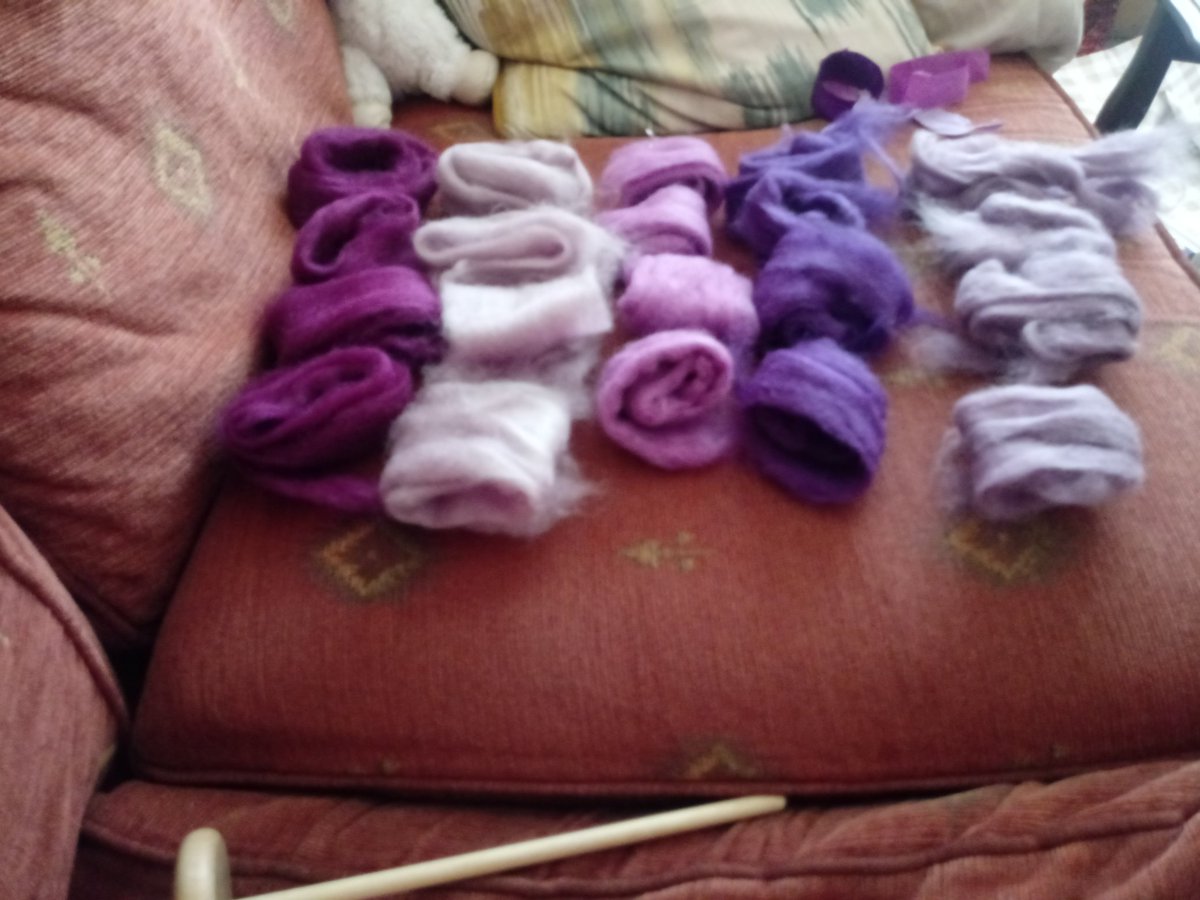Specifically, this is a lace-weight spindle, for making very thin yarn. Because that& #39;s the spindle I had a nice full-body picture of. Here is a normal weight spindle.
These are both drop spindles with top whirls and hooks, which are the kind I know how to use. You let the spindle dangle from the thread as you& #39;re spinning it and it drops lower as the thread gets longer. Or it drops all at once, when the thread breaks. That happens.
There are also drop spindles without hooks, or with the weight (it& #39;s called a whorl) at the bottom of the shaft (the stick), or with clever cross bar arrangements so you can wind the thread into a nice ball WHILE you spin, or support spindles that rest in a little cup.
A spindle is for turning fluff into yarn or thread. Yarn and thread are the same thing, structurally. Yarn is fat and fluffy, thread is thin and smooth, but you make them in the same basic way.
Here is a lovely picture of some unspun wool fluff. It is very soft.
Here is a lovely picture of some unspun wool fluff. It is very soft.
Don& #39;t you just want to smush your face in it? But while it is very soft and very cuddly it does NOT have structural integrity and the individual fibres pull apart if they snag on ANYTHING, like seriously it will snag on velvet if you& #39;re not careful, so it makes a terrible hat.
So you take the fluff and you take the spindle and through CUNNING DEXTROUS TRICKERY which I will not try to describe you dangle the one from the other and you spin it like a top, and because it is dangling, the twist goes from the spindle into the fluff above it.
So you get something like this, where it& #39;s fluff at the top, and yarn at the bottom, and in the middle MAGIC IS HAPPENING.
Twist is what makes fluff into string. Because it sticks together, you see. It only has a little bit of grip when it& #39;s all combed out soft and loose. When you draw it out thin and twist it repeatedly, the little bit of grip adds up and suddenly it can hold weight.
Like the spindle! It has to hold up the whole spindle! That& #39;s not a lot, honestly, my normal spindle weighs 37g and the spun yarn is strong enough I can& #39;t snap it between my hands, but the place where the magic happens is NOT that strong. It is still partly loose and slippery.
Which is why making lace takes a teeny tiny spindle. That pretty green one we started with? Weighs twenty seven grams. I& #39;ve seen them sold at twenty two grams. TEENY SPINDLES. SMALLER THAN A MOUSE.
These are both being spun from mixed fluff. The brown is Shetland, undyed white and undyed brown (from white and brown sheeps) partly blended so there& #39;s stripes of each. The green and white is dyed Merino. Spun without regard to the mix, you get a nice mottled effect.
You can take your colours and split them into sections, and then spin the colours separately. Like this with light grey and dark grey, spun into separate singles. There& #39;s less than it looks like because I wound them onto tennis balls.
Or you can take your colours and split them into sections and then, spin them into ONE single, with sequential blocks of colour. Like this with the purple. Pretty!
Then you take your singles, you line them up together, and you spin them BACKWARDS. This is called plying and it is ALSO magic, because the singles want to tangle or fall apart, and plying them puts opposite twist in, and it cancels out, and the yarn becomes polite.
If your singles are all the same colour, or mottled in the same colours, you get yarn that matches itself.
If you ply two singles in different colours, you get BARBER-POLE!
If you ply two singles in different colours, you get BARBER-POLE!
But what about the purple? What about these lovely stripes? If they& #39;re plied together, the singles won& #39;t match, and the colours will get mixed up, unless the colour changes happen at exactly the same place in every single and look, I span them, I guarantee they do NOT.
in this case we do something EXTRA MAGICAL and it is called chain-plying. You double the single back on itself and ply it with itself. So it goes up from spindle to hand, back down, back up, and you ply that section, and then pull another section through the loop and go again.
And then you take it off the spindle and give it a nice hot bath and a stretch, for that extra politeness factor, and you have made yarn! Out of fluff and a stick! You are a wizard!

 Read on Twitter
Read on Twitter













